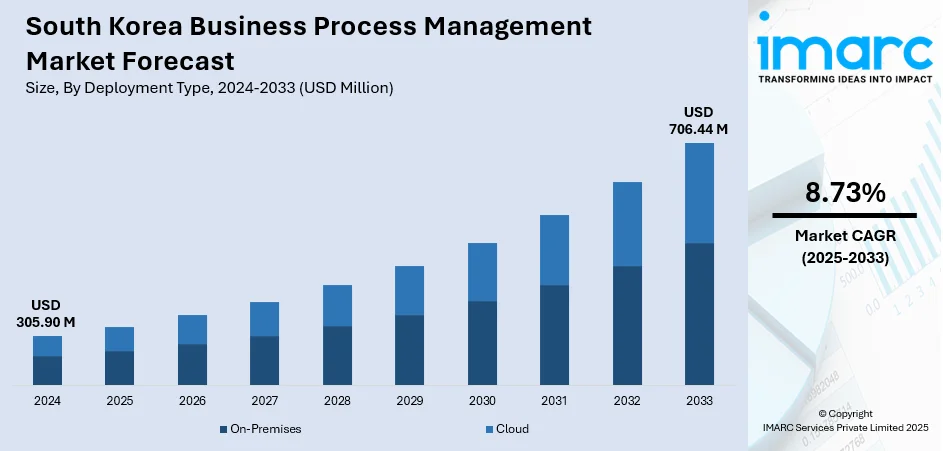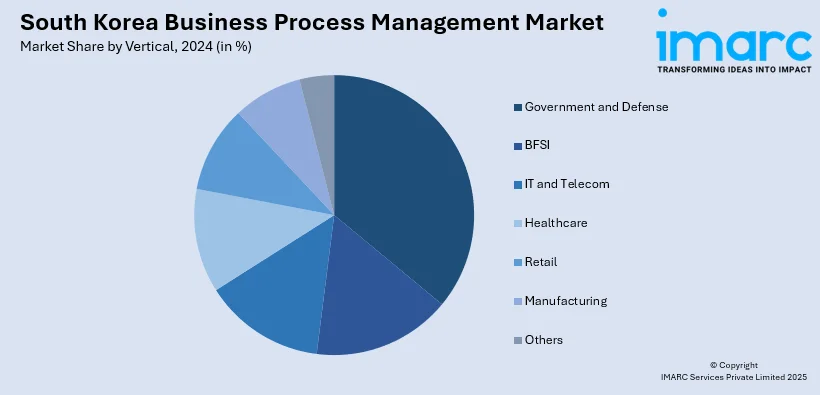
South Korea Business Process Management Market Size, Share, Trends and Forecast by Deployment Type, Component, Business Function, Organization Size, Vertical, and Region, 2025-2033
South Korea Business Process Management Market Overview:
The South Korea business process management market size reached USD 305.90 Million in 2024. Looking forward, the market is expected to reach USD 706.44 Million by 2033, exhibiting a growth rate (CAGR) of 8.73% during 2025-2033. The market is expanding steadily, driven by digital transformation across industries, increased demand for workflow automation, and the adoption of cloud-based solutions. Enterprises are also focusing on operational efficiency and agile business models to remain competitive. These trends collectively support the continued growth of the South Korea business process management market share.
|
Report Attribute
|
Key Statistics
|
|---|---|
|
Base Year
|
2024 |
|
Forecast Years
|
2025-2033
|
|
Historical Years
|
2019-2024
|
| Market Size in 2024 | USD 305.90 Million |
| Market Forecast in 2033 | USD 706.44 Million |
| Market Growth Rate 2025-2033 | 8.73% |
South Korea Business Process Management Market Trends:
Acceleration of Digital Transformation and Automation Initiatives
South Korea’s BPM market is significantly driven by widespread digital transformation across industries, including manufacturing, finance, healthcare, and retail. Organizations are adopting BPM platforms to streamline internal workflows, reduce operational inefficiencies, and automate repetitive processes. Amidst the increased focus on cloud computing, artificial intelligence (AI), and robotic process automation (RPA), companies are incorporating BPM tools to increase real-time decision-making and agile capacity. The transition to remote and hybrid working conditions has also led to the growth of the need to have visibility in processes and digital coordination. With the tide of companies focusing on end-to-end optimization of their operations to make it in the fast-renewing market, BPM systems are increasingly becoming the pivot and key towards the organization having the capability of realizing agility, compliant, and customer-centric delivery of services, putting BPM system at the center of it all.

To get more information on this market, Request Sample
Strong Government Support and Smart Industry Policies
The South Korean government’s active promotion of Industry 4.0, digital infrastructure, and smart factory development is a key catalyst for BPM adoption. Initiatives such as the “Digital New Deal” and support for smart manufacturing encourage enterprises, especially SMEs, to embrace process automation and optimization tools, which are boosting the South Korea business process management market growth. Regulatory mandates around data privacy, process traceability, and quality assurance further push organizations toward formalized business process systems. Additionally, the digitization of public services has increased the use of BPM in government operations, setting a standard for efficiency and transparency. Combined with funding support, tax incentives, and public-private innovation programs, these policy-driven efforts create a conducive environment for BPM expansion across both public and private sectors.
Rising Demand for Operational Efficiency and Business Agility
As South Korean enterprises face increasing market complexity and global competition, there is a strong push to enhance operational efficiency and organizational agility. BPM solutions allow companies to map, monitor, and optimize key business functions, ranging from supply chain and HR to customer service and compliance. Through intelligent automation, error reduction, and process reengineering, BPM platforms help reduce costs and boost productivity. In fast-paced industries like logistics, telecommunications, and e-commerce, BPM also enables real-time process adjustments and data-driven decisions. By improving coordination across departments and eliminating bottlenecks, BPM empowers organizations to respond swiftly to changing market demands while maintaining high standards of quality and performance.
South Korea Business Process Management Market Segmentation:
IMARC Group provides an analysis of the key trends in each segment of the market, along with forecasts at the country and regional levels for 2025-2033. Our report has categorized the market based on deployment type, component, business function, organization size, and vertical.
Deployment Type Insights:
- On-Premises
- Cloud
The report has provided a detailed breakup and analysis of the market based on the deployment type. This includes on-premises and cloud.
Component Insights:
- IT Solution
- Process Improvement
- Automation
- Content and Document Management
- Integration
- Monitoring and Optimization
- IT Service
- System Integration
- Consulting
- Training and Education
A detailed breakup and analysis of the market based on the component have also been provided in the report. This includes IT solution (process improvement, automation, content and document management, integration, and monitoring and optimization) and IT service (system integration, consulting, and training and education).
Business Function Insights:
- Human Resource
- Accounting and Finance
- Sales and Marketing
- Manufacturing
- Supply Chain Management
- Operation and Support
- Others
The report has provided a detailed breakup and analysis of the market based on the business function. This includes human resource, accounting and finance, sales and marketing, manufacturing, supply chain management, operation and support, and others.
Organization Size Insights:
- SMEs
- Large Enterprises
A detailed breakup and analysis of the market based on the organization size have also been provided in the report. This includes SMEs and large enterprises.
Vertical Insights:

- Government and Defense
- BFSI
- IT and Telecom
- Healthcare
- Retail
- Manufacturing
- Others
A detailed breakup and analysis of the market based on the vertical have also been provided in the report. This includes government and defense, BFSI, IT and telecom, healthcare, retail, manufacturing, and others.
Regional Insights:
- Seoul Capital Area
- Yeongnam (Southeastern Region)
- Honam (Southwestern Region)
- Hoseo (Central Region)
- Others
The report has also provided a comprehensive analysis of all the major regional markets, which include Seoul Capital Area, Yeongnam (Southeastern Region), Honam (Southwestern Region), Hoseo (Central Region), and others.
Competitive Landscape:
The market research report has also provided a comprehensive analysis of the competitive landscape. Competitive analysis such as market structure, key player positioning, top winning strategies, competitive dashboard, and company evaluation quadrant has been covered in the report. Also, detailed profiles of all major companies have been provided.
South Korea Business Process Management Market Report Coverage:
| Report Features | Details |
|---|---|
| Base Year of the Analysis | 2024 |
| Historical Period | 2019-2024 |
| Forecast Period | 2025-2033 |
| Units | Million USD |
| Scope of the Report |
Exploration of Historical Trends and Market Outlook, Industry Catalysts and Challenges, Segment-Wise Historical and Future Market Assessment:
|
| Deployment Types Covered | On-Premises, Cloud |
| Components Covered |
|
| Business Functions Covered | Human Resource, Accounting and Finance, Sales and Marketing, Manufacturing, Supply Chain Management, Operation and Support, Others |
| Organization Sizes Covered | SMEs, Large Enterprises |
| Verticals Covered | Government and Defense, BFSI, IT and Telecom, Healthcare, Retail, Manufacturing, Others |
| Regions Covered | Seoul Capital Area, Yeongnam (Southeastern Region), Honam (Southwestern Region), Hoseo (Central Region), Others |
| Customization Scope | 10% Free Customization |
| Post-Sale Analyst Support | 10-12 Weeks |
| Delivery Format | PDF and Excel through Email (We can also provide the editable version of the report in PPT/Word format on special request) |
Key Questions Answered in This Report:
- How has the South Korea business process management market performed so far and how will it perform in the coming years?
- What is the breakup of the South Korea business process management market on the basis of deployment type?
- What is the breakup of the South Korea business process management market on the basis of component?
- What is the breakup of the South Korea business process management market on the basis of business function?
- What is the breakup of the South Korea business process management market on the basis of organization size?
- What is the breakup of the South Korea business process management market on the basis of vertical?
- What is the breakup of the South Korea business process management market on the basis of region?
- What are the various stages in the value chain of the South Korea business process management market?
- What are the key driving factors and challenges in the South Korea business process management market?
- What is the structure of the South Korea business process management market and who are the key players?
- What is the degree of competition in the South Korea business process management market?
Key Benefits for Stakeholders:
- IMARC’s industry report offers a comprehensive quantitative analysis of various market segments, historical and current market trends, market forecasts, and dynamics of the South Korea business process management market from 2019-2033.
- The research report provides the latest information on the market drivers, challenges, and opportunities in the South Korea business process management market.
- Porter's five forces analysis assist stakeholders in assessing the impact of new entrants, competitive rivalry, supplier power, buyer power, and the threat of substitution. It helps stakeholders to analyze the level of competition within the South Korea business process management industry and its attractiveness.
- Competitive landscape allows stakeholders to understand their competitive environment and provides an insight into the current positions of key players in the market.
Need more help?
- Speak to our experienced analysts for insights on the current market scenarios.
- Include additional segments and countries to customize the report as per your requirement.
- Gain an unparalleled competitive advantage in your domain by understanding how to utilize the report and positively impacting your operations and revenue.
- For further assistance, please connect with our analysts.
 Request Customization
Request Customization
 Speak to an Analyst
Speak to an Analyst
 Request Brochure
Request Brochure
 Inquire Before Buying
Inquire Before Buying




.webp)




.webp)












